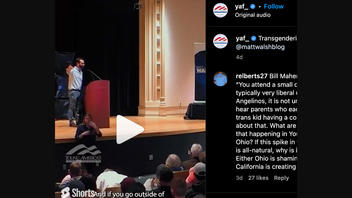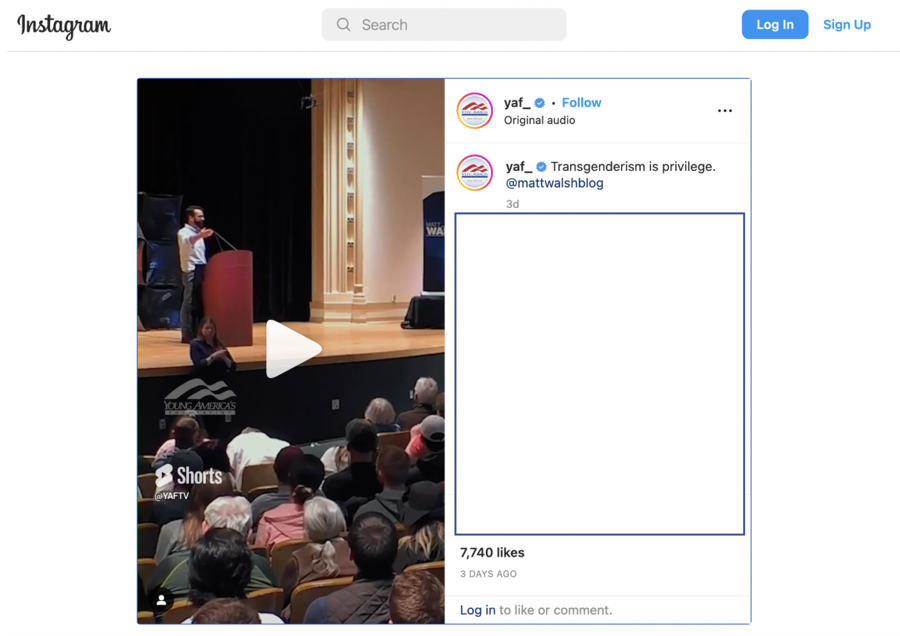
Are transgender people and gender fluidity "products" of modern Western civilization? No, that's not true: Non-binary gender expression in many communities across the globe throughout history has been documented and researched. Professor Lisa Duggan told Lead Stories that even though people of earlier epochs did not necessarily conceptualize themselves through the optics of present-day terms, the phenomena are not modern or Western in origin.
The claim appeared in a post on Instagram on March 4, 2023. The caption said:
Transgenderism is privilege.
In the shared video the man who appears to be delivering a public lecture continued:
Gender ideology is a product, it's a very insular, Western, modern thing. It's a product of our Western privilege.
Here is what it looked like at the time of writing:
The claim that transgender identity is exclusively modern and Western depends on the definition of 'transgender.' People with gender presentations that cross categories or lie between them are found widely in premodern and non-western societies. There is a lot of research on two-spirit Native identities and on the hijira in India, for example. But these gender non conforming people are not the same as modern western 'transgender' people, just as people with same gender sexual relations are not the same as modern 'gay' people.So, cross gender and between gender and multiple genders generally, as well as same gender sexual relations, are not at all confined to the modern West. But the specific terminology and cultural formations of 'gay' or 'transgender' are culturally and historically located.The post you cite is in bad faith. The authors intend to mislead.
Gender refers to the combination of characteristics, expectations, and roles usually associated with one's sex assigned at birth - often placed on a spectrum between masculine and feminine. The concept of gender is complicated because most aspects of gender are social constructs that vary across time and culture. For example, gender presentation (appearance, clothing, mannerisms, and behaviors) and gender roles (social roles, occupational choices) vary widely depending on the culture and era.
It continues:
A central aspect of gender is gender identity. Gender identity is the self-image that one has about one's own gender as masculine, feminine, or otherwise.
In 1629, the Virginia Court in Williamsburg heard testimony to decide the fate of one Thomasine or Thomas Hall, apparently an individual born with physically ambiguous genitalia who lived as both a man and a woman at different periods of life. Raised in England as a girl, Hall presented as a man to become a sailor, presented again as a woman to work as a lacemaker, and eventually became an indentured servant in Virginia as a man. Accused of performing an illicit sexual act with a female servant, the question before the Virginia Court was to determine whether Hall was male, and therefore guilty of fornication, or female, and therefore guilty of no crime, given that sexual activity between women was considered physically impossible. Unable to reach a conclusion, the court ordered Hall to wear a mix of men's and women's clothing.
Though Two-Spirit may now be included in the umbrella of LGBTQ, The term 'Two-Spirit' does not simply mean someone who is a Native American/Alaska Native and gay.
Traditionally, Native American two-spirit people were male, female, and sometimes intersexed individuals who combined activities of both men and women with traits unique to their status as two-spirit people. In most tribes, they were considered neither men nor women; they occupied a distinct, alternative gender status ...
Two-spirit identity was widely believed to be the result of supernatural intervention in the form of visions or dreams and sanctioned by tribal mythology. In many tribes, two spirit people filled special religious roles as healers, shamans, and ceremonial leaders.
I met among the Russian creoles of the Lower Kolyma, who do not differ practically from the Russianized Yakaghir of the same locality, an old man who had a bearded face and the outer genital organs of a male. Notwithstanding this, he acted like a woman throughout his whole life. He wore woman's dress, performed woman's work, and even in his conversation applied to himself the feminine gender, for which the Russian language presents numerous occasions.
Another case was of a young girl who likewise assumed man's clothing, carried a spear, and even wanted to take part in a wrestling contest between young men. While tending the herd, she tried to persuade one of the young herdswomen to take her for a husband.
The most common example of this phenomenon is the practice referred to by the term couvade. Most commonly found among peoples in the Amazon basin (Gregor, 1985), the couvade is also found in Melanesia (Blackwood, 1935; Meigs, 1976). In general, during some portion, or all, of his spouse's pregnancy and childbirth, a man takes on some aspects of the woman's behavioral complex. This may range from observing the same food regulations to taking to his bed and experiencing the pains of childbirth, or observing restrictions on sexual activity. Sometimes, the couvade lasts until the child is weaned. ...Among the Gabra in Kenya and Ethiopia, men, as they age, pass through a period in which they are said to be women (Wood, 1996, Wood, 1999). In a slightly different vein, Turnbull (1986) argues that the Mbuti in the Ituri Rainforest region of the Democratic Republic of Congo are genderless until they marry; that is, they pass through childhood without a distinct gender identity and are transformed only later.















